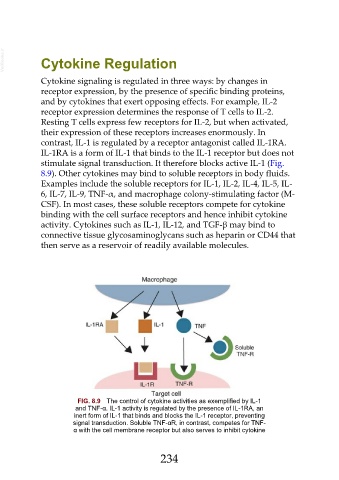Page 234 - Veterinary Immunology, 10th Edition
P. 234
VetBooks.ir Cytokine Regulation
Cytokine signaling is regulated in three ways: by changes in
receptor expression, by the presence of specific binding proteins,
and by cytokines that exert opposing effects. For example, IL-2
receptor expression determines the response of T cells to IL-2.
Resting T cells express few receptors for IL-2, but when activated,
their expression of these receptors increases enormously. In
contrast, IL-1 is regulated by a receptor antagonist called IL-1RA.
IL-1RA is a form of IL-1 that binds to the IL-1 receptor but does not
stimulate signal transduction. It therefore blocks active IL-1 (Fig.
8.9). Other cytokines may bind to soluble receptors in body fluids.
Examples include the soluble receptors for IL-1, IL-2, IL-4, IL-5, IL-
6, IL-7, IL-9, TNF-α, and macrophage colony-stimulating factor (M-
CSF). In most cases, these soluble receptors compete for cytokine
binding with the cell surface receptors and hence inhibit cytokine
activity. Cytokines such as IL-1, IL-12, and TGF-β may bind to
connective tissue glycosaminoglycans such as heparin or CD44 that
then serve as a reservoir of readily available molecules.
FIG. 8.9 The control of cytokine activities as exemplified by IL-1
and TNF-α. IL-1 activity is regulated by the presence of IL-1RA, an
inert form of IL-1 that binds and blocks the IL-1 receptor, preventing
signal transduction. Soluble TNF-αR, in contrast, competes for TNF-
α with the cell membrane receptor but also serves to inhibit cytokine
234

